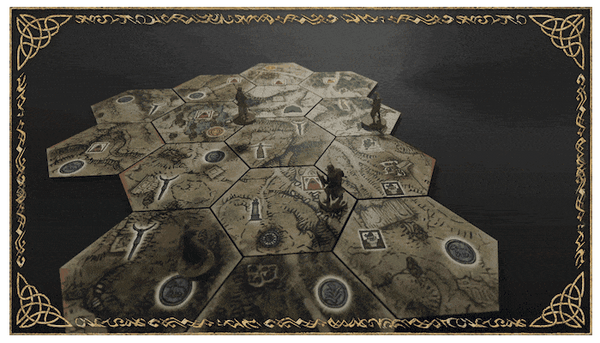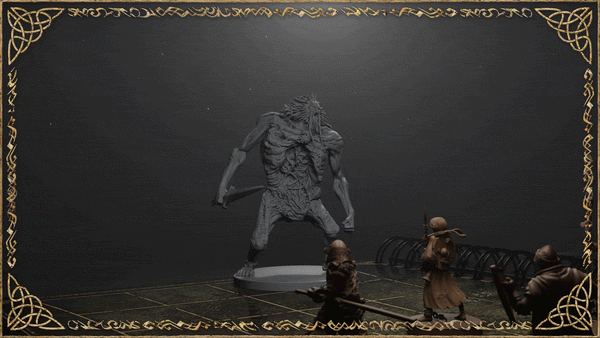Gameplay Overview | ELDEN RING: The Board Game


Want to learn more about the ELDEN RING board game, now live on Kickstarter? Click here to download the rulebook, or read the overview below…
(Or watch this 5-minute guide on YouTube: https://youtu.be/In10eBLGq6k)
Begin Your Campaign

Welcome to the tabletop Lands Between, a mysterious and otherworldly realm where the landscape is rich and varied. You find yourself in Limgrave, where an epic campaign of evolving quests and intriguing side quests awaits.
You may undertake your campaign cooperatively, with up to three fellow Tarnished; solo, if you’re feeling brave; or in story mode, where you’ll have more time to spend wandering the landscape.
Whichever mode you choose, you can always return to play a different way at a later date. The campaign is fully replayable with a story that evolves with the choices you make. Each session is playable in 90-120 minutes and the core box campaign will span 40 hours, increasing to 90 hours with the expansions.
The Tarnished character you build can also make the entire journey with you, from one region to the next…
Open World, Modular Exploration

As you explore you’ll build an overworld map of your surroundings by drawing and laying hex tiles, revealing unique locations to visit, resources to gather, NPC’s to interact with, and enemies to fight. The Stakes of Marika you’ll find will give you extra lives. Sites of Grace will restore your health but reset all enemy encounters, just like the video game.
You’ll begin with a single tile, minimising set-up time. Because tile draw is random, your map will change in each campaign. But because you’ll be drawing from specified tile stacks, you’ll still encounter key NPC’s and locations for a particular quest.
Still, you won’t know when and where they’ll emerge, or what obstacles might stand in your way, ensuring a fresh experience when you play the campaign again. You’ll also encounter side-quests and delve into emergent narrative, depending upon the decisions you make.
Guidance of Grace Deck

Like the guiding light in the video game, your progress is tracked by the Guidance of Grace deck which you’ll draw from at the start of each quest. As well as fragments of narrative, this deck gives you objectives to complete and reveals the ultimate goal of each quest.
Depending on the quest, you might draw single Guidance of Grace cards that work in a series, unlocking one after another, or a field of options offering multiple potential ways for you to succeed.
But where there is opportunity for success, there is also the chance of failure. Greater Will tokens are there to prevent your party wandering — and grinding — forever. Each turn that passes where you don’t contribute toward one of your objectives, you’ll discard a Greater Will token from your party’s shared pool. Once the tokens run out, so has your time.
Should you wish to roam for longer, story mode is for you.
Read more about the Guidance of Grace deck
Mysterious Card Vault

Alongside the Guidance of Grace deck is the card vault. Inside this vault are events, items, and enemies that will remain hidden until they’re needed… or discovered. These cards are numbered, only drawn and shuffled into various decks when triggered by your decisions.
Because each session begins with laying just a single tile, and card decks are customised as you play, set-up time is minimised and you're plunged quickly into the action.
Read more about the Card Vault
Quest Books & Battle Grid

As you explore, you’ll often encounter enemies standing in the way of crucial objectives, who’ll need to be defeated before you can complete your goals. Like the video game, combat is both deadly and personal. While exploration occurs on the sweeping vistas of the overworld map, combat narrows your view until it’s just you, your opponent(s), and the fight for survival.

Combat takes place in your individual quest book, face-to-face with your foes. The game will indicate which page you should turn to. The battle grid will indicate starting positions, and the opposing page your objective, any special rules, and rewards if you succeed. And combat will swiftly begin.
Because combat takes place in your individual quest book, your encounters also won’t disrupt play for everyone else. After making the three actions in your turn — and enduring any enemy attacks — your combat will pause while the other Tarnished continue exploring the overworld, with combat resuming once your turn comes back around. This also gives you vital time to plan your next move.
But what about boss encounters? When your party locates a dungeon, your quest books will be joined together, allowing you to take on bosses together on a much larger stage while still being up close and personal.
Boss encounters aren’t the only time you’ll fight side by side. If one of your fellow Tarnished is in trouble, there are also ways to step inside their quest book and lend a hand — or a blade. Remember, a wrong move can mean death to the unwary, sending unlucky Tarnished back to the nearest Site of Grace to respawn.
Battle Stance System

Unique to the ELDEN RING board game, the battle stance system raises the level of combat from one of simple physical positioning to state of mental readiness. Using a grid made up of rows and lanes, this system means your position dictates not only your physical position in the encounter, but your battle stance: aggressive, neutral, or defensive.
Each battle stance has benefits and drawbacks to exploit and avoid with the changing state of combat, which can even vary from one encounter to the next. An aggressive stance can give you additional card draw, but may also benefit your enemies, while a neutral stance may let you manipulate the marching order, to change the flow of combat. A defensive stance may let you regain stamina, biding your time until you’re ready to advance again.
Read more about the Battle Stance System
Hear more about the Battle Stance System
Deck Building & Diceless Combat

Each combat encounter is divided into rounds. At the start of each round, the initiative cards for each character involved in the combat encounter are dealt in a row. Drawn at random but possible to manipulate, this ‘marching order’ will determine which characters act when, and tell you which enemy attacks will happen when. This gives you the vital opportunity to plan ahead, just as you’d learn ‘tells’ in the video game.
Understanding enemy attack patterns is key, helping to inform when to expose an enemy weakness and press home an attack, and when to play defensively while your stamina returns. Crucially, your hand of attack and defence cards represents your stamina, so you’ll need to choose carefully when to press forward and when to conserve or regain energy.
Bosses are faster and more dangerous, with multiple initiative cards. This allows them to make multiple attacks per round, and significantly vary their offence in a way regular enemies cannot. It also lets you read their ‘tells’ and react accordingly when you see an attack coming… if you can.
Combat is card-driven and diceless with strong elements of deck-building. As your Tarnished character levels up, you’ll need to build your attack and effect decks to best optimise with your equipment.
Read more about Deck Building & the Marching Order
Deep Character Customisation & Levelling Up

At the end of each quest, you’ll retire to the Roundtable Hold. It's here you’ll plan your next quest, meet with some NPC’s to further side-quests, buy and craft items using the materials you’ve found, level up your equipment with smithing stones — and, most importantly, spend your runes to level up your Tarnished.
When it comes to customising your Tarnished, you aren’t limited to fixed progression paths. As well as crafting new equipment, there are eight character traits you can increase when levelling up in the board game. Strength, Dexterity, Intelligence and Faith all customise your effect deck, while Vigour, Endurance, Arcane, and Mind offer you a variety of special rules and focuses.
You can build your Tarnished, your way, and carry them forward through your campaign.
Read more about Customisation & Levelling Up







